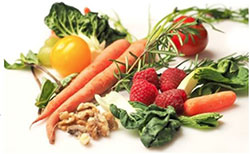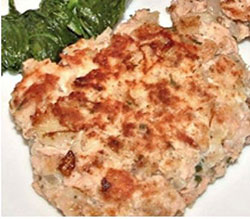Seafood the Superfood
Sheila Gains, Family & Consumer Science Extension Agent, Arapahoe County

Just like an athlete trains his/her mind and body to perform at their best; students need to train their minds and bodies to perform their best at school. For best results start a training schedule several weeks to a month before school starts.
Brain Training Includes:
Eating Right – Get in the habit of serving a healthy breakfast every morning. Include one or more of these 10 brain foods as part of each meal or snack. These foods provide important brain nutrients such as B vitamins, antioxidants and omega 3’s.
- Berries – Enjoy plain or on top of cereal, in a smoothie or yogurt parfait, etc. Try strawberries, cherries, blueberries, blackberries and raspberries.
- Nuts – Eat them plain or as nut butter in a sandwich, ants on a log (celery stuffed with peanut butter and topped with raisins), or a banana rolled in crushed nuts, etc. If allergic to peanuts try sunflower seeds or sunflower seed butter.
- Leafy Greens – Try kale chips, salad, spinach omelet, stir-fried bok choy or Napa cabbage, etc.
- Other Vegetables – Eat a wide variety of vegetables such as corn, carrots, sweet potatoes, beets, broccoli, green beans, peas, cucumbers, tomatoes, pumpkin, etc.
- Fish – Salmon is a great source of heart healthy Omega-3 fatty acids. Canned salmon is usually the most economical, but fresh or frozen salmon is just as nutritious. Instead of tuna sandwiches try salmon salad sandwiches using canned salmon or make salmon patties. Grill fresh or frozen salmon and offer it with a sauce for dipping or make it into fish tacos.
- Poultry – Include sliced turkey in a sandwich, shredded chicken on a salad, cooked ground chicken or turkey in a lettuce wrap, casserole or soup, etc.
- Whole Grains – Look on the label for a whole grain as the first ingredient in breads, tortillas, wraps, cold cereals, oatmeal, crackers, popcorn, etc. Examples include whole wheat, whole corn, brown rice and whole oats.
- Beans – Kidney, pinto, black, navy, and garbanzo are all great sources of protein, carbs, and fiber plus lots of vitamins, minerals and omega 3 fatty acids. Try them in soups, burritos, salads, casseroles, or as dips and spreads.
- Eggs – Enjoy them scrambled, poached or hard boiled. Eggs can be part of a healthy breakfast, lunch, dinner or snack. Make easy to grab breakfast burritos with scrambled eggs, cheese and sautéed vegetables in a whole wheat tortilla. Freeze leftovers to pop in the microwave on a morning you are running short of time.
- Milk, Yogurt and Low-fat Cheese – Drink a glass, make a smoothie or have a slice or stick of low-fat cheese as a snack.
Complement these foods with a wide variety of other fruits and lean meats or meat substitutes. The American Medical Association and the Academy of Nutrition and Dietetics recommend that healthy children get their nutrients from foods rather than vitamin supplements.
Brain Training Also Includes:
Sleep – 8- 12 hours a night. Have children practice going to bed and getting up at the times they will when school starts.
Physical Activity – Keep kids physically active for a total of 1 hour a day. This can be broken down into (2) 30 minute walks, or (3) 20 minute bike rides, or (4) 15 minute runs. Any combination of physical activity totaling 1 hour a day is the goal.
Brain Training – If your kids haven’t picked up a book all summer, have them start reading 10-20 minutes a day, then increase the time until they are reading 30-45 minutes a day before school starts. This helps them brush up on reading skills and increases their concentration and attention. Practice a few math problems every day for a few weeks. Book stores and public libraries have a variety of math workbooks to help children brush up on math skills.
Let’s Talk
Children might respond better to the idea of healthy eating, sleeping and moving, if parents put the desired behavior changes into the context of sports training. Pick their favorite sport or sports player and explain to children that to get good at sports, athletes have to train hard by eating healthy, getting enough sleep, exercising and practicing every day. In addition to being good at sports, student athletes need to keep their grades up to avoid being benched or sidelined. Most professional athletes were student athletes first.
Just for parents:
Adults who also follow these recommendations may reduce cognitive decline and the risk of Alzheimer’s disease. For more information on the potential impact of the MIND diet on adults go to www.liveeatplay.colostate.edu/eat/healthy-diet/mind/index.php
Recipes for Health:

Salmon Patties
Ingredients:
1 (14-15 oz.) can red salmon, drained
2 Tablespoons mayonnaise or salad dressing
½ cup cracker crumbs
¼ – ½ cup of finely diced vegetables (carrots, celery, red bell pepper, green onions, corn, pickle relish, etc.)
2 eggs, beaten
Cooking oil
Directions:
- Mix all the ingredients except eggs together and adjust seasoning (salt, pepper, paprika, etc.).
- Add beaten eggs to salmon mixture, mix thoroughly.
- Form into patties. Makes about five 1/3 cup patties.
- Sauté patties in fry pan, over medium high heat, in 1-2 Tablespoons oil. Brown on both sides, then lower heat and cook another 5-6 minutes.
Sources:
www.liveeatplay.colostate.edu/eat/healthy-diet/mind/index.php
www.liveeatplay.colostate.edu Important Nutrition for Health and Growth
www.webmd.com Top 10 Brain Foods for children
www.onhealth.com Top Brain Foods for Children





